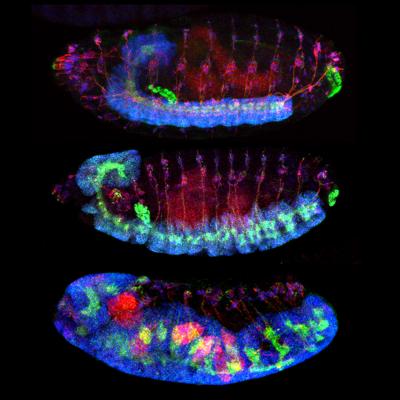International team discovers novel Alzheimer's disease risk gene among Icelanders

This is a wild-type Drosophila a. (top) and human TM2D3 (middle) genomic constructs rescue the aberrant nervous system overgrowth seen in embryos laid by mutant females (bottom, no rescue construct). Blue: nuclei, Green: membranes, Red: cytoskeleton. Credit: S. Yamamoto, J. Schuman, H. Bellen, Baylor College of Medicine
Alzheimer's disease is the most common cause of dementia among older adults, and the presence of certain genetic variants increases an individual's risk for developing this disease.
Baylor researchers Dr. Shinya Yamamoto, assistant professor of molecular and human genetics; Dr. Joshua M. Shulman, assistant professor of neurology, neuroscience, and molecular and human genetics, and Dr. Hugo J. Bellen, professor and director of the program in developmental biology and also an investigator at the Howard Hughes Medical Institute, were part of an international team that analyzed samples from 1,393 subjects with late-onset Alzheimer's disease and compared the results with those of 8,141 neurologically healthy individuals.
The consortium found a variant in TM2D3, a gene that has never been studied in human or other vertebrate species. Interestingly, while the probability of this variant was very rare among people of European ancestry, it was significantly enriched among Icelanders (but still less than 1 percent frequency). The researchers estimated that carriers of this variant would have an approximately six-fold increased risk of developing Alzheimer's disease.
To further understand the impact of the discovered mutation and its potential link to processes that lead to Alzheimer's disease, the Baylor researchers studied the function of TM2D3 in the fruit fly model system.
They found that loss-of-function of theTM2D3 gene causes abnormal development of the fly's nervous system. They next showed that human normal TM2D3 could functionally substitute for its fly counterpart and rescue the neurodevelopmental defect, whereas introduction of the Alzheimer's disease-associated variant was unable to restore the normal function.
In summary, this study has identified a novel, rare genetic variant in the TM2D3 gene to be a risk factor in the development of late-onset Alzheimer's disease among Icelanders. This gene has not been previously linked to Alzheimer's, andresearchers are hopeful that further investigations may lead to new and more effective therapies.
###
Other Baylor contributors to this work are Dr. David Li-Kroeger, postdoctoral fellow in the Bellen Lab, José Salazar, graduate student in the Bellen Lab, and Dr. Eric Boerwinkle at Baylor's Human Genome Sequencing Center.
Media Contact
All latest news from the category: Life Sciences and Chemistry
Articles and reports from the Life Sciences and chemistry area deal with applied and basic research into modern biology, chemistry and human medicine.
Valuable information can be found on a range of life sciences fields including bacteriology, biochemistry, bionics, bioinformatics, biophysics, biotechnology, genetics, geobotany, human biology, marine biology, microbiology, molecular biology, cellular biology, zoology, bioinorganic chemistry, microchemistry and environmental chemistry.
Newest articles

Trotting robots reveal emergence of animal gait transitions
A four-legged robot trained with machine learning by EPFL researchers has learned to avoid falls by spontaneously switching between walking, trotting, and pronking – a milestone for roboticists as well…

Innovation promises to prevent power pole-top fires
Engineers in Australia have found a new way to make power-pole insulators resistant to fire and electrical sparking, promising to prevent dangerous pole-top fires and reduce blackouts. Pole-top fires pose…

Possible alternative to antibiotics produced by bacteria
Antibacterial substance from staphylococci discovered with new mechanism of action against natural competitors. Many bacteria produce substances to gain an advantage over competitors in their highly competitive natural environment. Researchers…





















